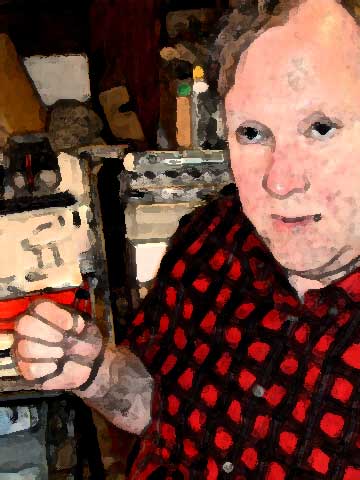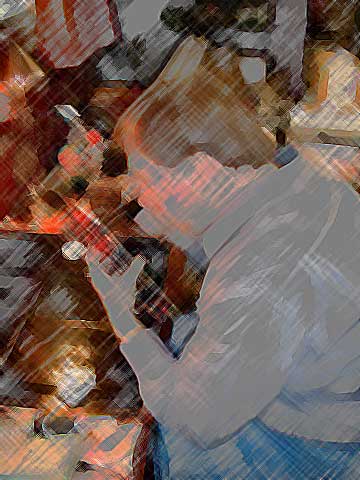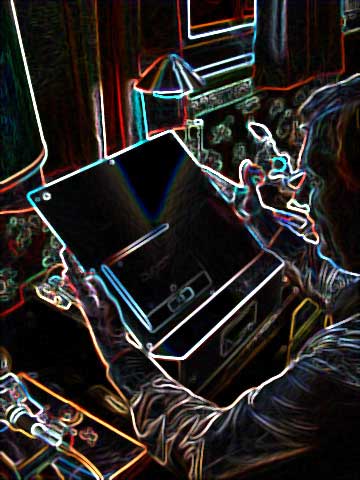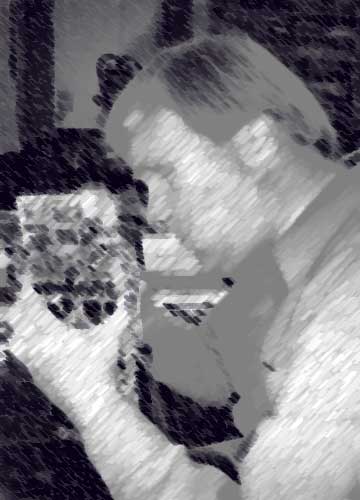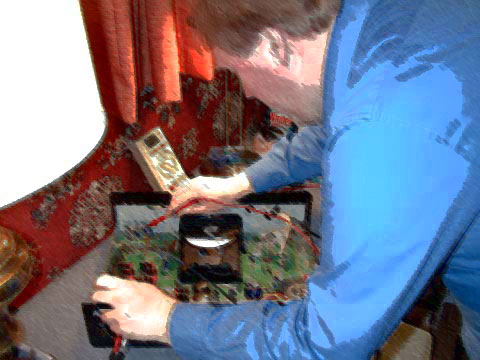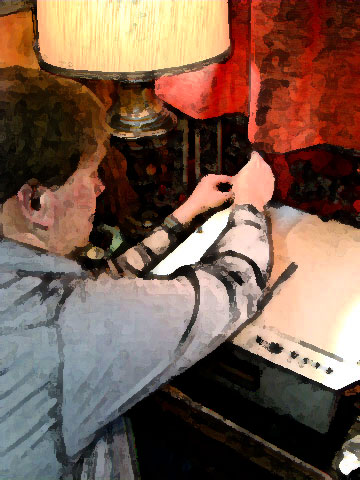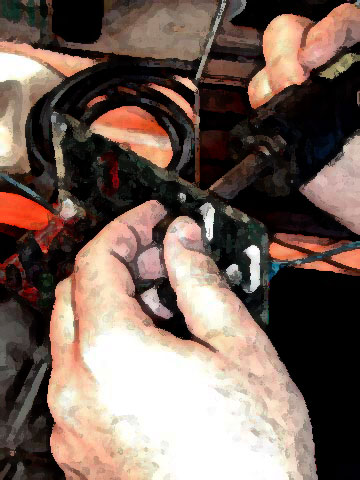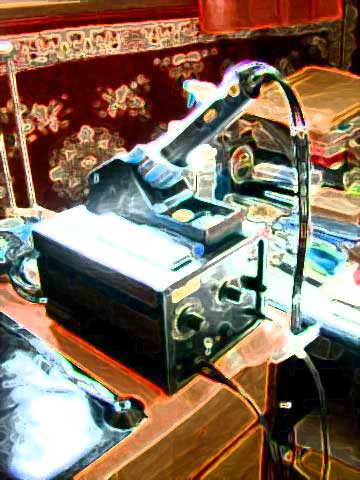|
You are reading the older HTML site
Positive Feedback ISSUE 6 Positive Feedback Online Interviews: Richard Kern of Audiomod
All photographs and image processing by Robinson
One of the real audio advantages of living in Portland is that two well known SACD modders/hotrodders live right here in River City. We have elsewhere in PFO Issue 6 published my interview with Dan Wright of ModWright. Herein follows my interview with Audiomod’s Richard Kern, conducted at his workshop in February, 2003, about a week after my conversation with Dan Wright. The transcription has been edited for the sake of clarity. Robinson: Richard, you and I have had a chance to get to know each other fairly well over the past handful of months as you have done a number of modifications on the reference SCD-1 player for Positive Feedback Online. A lot of people have read that series and have gotten very interested in the idea of modifying their SACD player. I would like to start out by finding out how the heck you got involved in fine audio, and how you became interested in doing the sort of work you do. Kern: Well, to give you my background: I am legally blind. I was born blind from birth, a premature baby. I have always had what seems to be more hearing acurity than other kids. I grew up in a family with classical music, good music on the radio, and I have always enjoyed music because it is a spiritual, relaxing thing. As a child I really enjoyed listening to classical. I wasn’t much into pop or rock at the time when I grew up in the '60s. When I got out on my own in the late '70s and started making my own living as a service technician repairing audio equipment, I started getting into high end audio. It was first with all the usual components back then, Harmon Kardon, Nakamichi, that kind of thing. Over the years I have progressed into the "name brand" units, Audio Research, Levinson, and that kind of equipment. I worked my way up to a pretty decent system I think by today’s standards.
Robinson: Yes, I have been impressed by the sound of your rig in here. It is very good. Do you remember the moment in your life at which you knew that audio was it for you? Kern: I would say probably as a teenager. I never really had a paper route or worked part-time. Electronics was a hobby for me. I started out going through high school electronics classes and eventually decided, hey, this is what I want to make a living at. I like this. I like what I am doing. It keeps me occupied. It is interesting. It is always changing. It is never the same thing twice. There are always new things to learn, new equipment, new toys to play with, new recordings to listen to. I got into vinyl quite heavily in the '70s when I graduated from college in '76. I started collecting records until CD's came out in '82-'83. I didn’t have the greatest vinyl rig by today’s standards, but that really piqued my interest in audio. It gave me quite an appreciation for fine music. It spurred my interest as to how much better equipment can be than what most people normally listen to for their playback system. It was obvious that friends and relatives had systems back then that we would consider today to be junk. Another reason that spurred me into this hobby is that the average person doesn’t know how good stereos can be, or how good music or sound reproduction in the home can be, until they experience fine audio. Robinson: Did you have any particular books that you ran across that stirred you along this way, or something that took you from the high school class in electronics on into fine audio?
Kern: That’s what is interesting. Unlike a lot of people, I didn’t really have any mentors. I spent a lot of years searching for what fine audio was, or could be, because what most of your readers don't realize is that in Portland, Oregon—at least when I was growing up—there were not a lot of choices for fine audio. There were one or two shops at the most, and they were usually run by guys who didn’t have a lot of money and couldn’t display a lot of stuff. Audio back then was kind of an underground hobby. Getting The Absolute Sound—you couldn’t find it anywhere; it was found by word of mouth. I would say probably my mentors into getting into audio at the time were The Absolute Sound magazine, and Stereophile. I started reading those and I said "Wow, there is another world out there!" beyond the mid-fi equipment that I was servicing and owning at the time. Most of the equipment they reviewed, I couldn’t afford, but at least it gave you something to shoot for. When I was able to hear good equipment in the audio stores in town, I would say to myself "OK, now I know for the moment where this equipment can go and where the technology can take us." So I started to investigate what I could do internally on components for my personal use, and then for friends and relatives. Then I started investigating the possibility of putting better parts in them, or, like a lot of people at the time, putting in tube sections in CD players. I was doing a lot of tweaking during the '80s. Anything that came out with CDs which involved tweaking, like green pens, or demagnetization, or anti-static guns—I was doing it. The "wire of the month," new topologies of winding wire, things of that nature, I would go for it. I ended up trying a lot of different brands of wire trying to find out which wire I liked the best, what geometry suited me best. I also investigated speakers, because there are a lot of poor quality components inside speakers. People don't realize how even the good audiophile companies can put some pretty pathetic parts inside a speaker crossover. During the mid-'80s I got into Apogee ribbons and Magnepans and Martin Logan electrostats and played around with these, doing cross over upgrades to them. That piqued my tweaking interest some more. I got into the habit of—if not tweaking my own stuff—tweaking my friend's stuff. We did a lot of experiments back and forth, changing a part here or part there, rewiring this or that. We would hear the difference, and then we would go compare it to the latest hot system at the local audio salon. It was a lot of fun doing that kind of adventuresome experimentation. Robinson: During all of this time, you were acting as an independent? Kern: Yes, basically while I was working with several companies in the Portland area. From about '78-'87, I was working for Fred's Sound of Music. At that time they were very much one of THE stores to go to — besides Chelsea Audio and Magnolia and Hawthorne Stereo—if you wanted good stereo. At the time, ironically they only carried mid-fi brands like Sony, Harmon Kardon. Nothing really high end. Speakers were maybe Kef, Dahlquist, JBL. It was a good place to learn repairing, and a good place to learn how to get into equipment and tweak. If you come from a repair background, equipment doesn’t scare you. I don't have any problems getting into equipment and doing what I have to do. Whereas if you come from an engineering point of view, you may know how to design a good circuit, but a lot of engineers don't really like to go in and fix stuff or do any kind of modifications. They tend to be scared away by it. For me it was a good segue.
Robinson: Engineering vs. troubleshooting/diagnostics are two completely different worlds—in computing as well as in audio. So at this time then, through the '80s, you were working as a technician? Kern: Yes. In about '87 I moved up to Seattle and worked for a couple of companies there, including Carver Corporation for a couple of years as one of their warranty service technicians. That was quite an eye-opener, because his equipment is touted as being high end, but if you look inside of it the parts quality is anything but high end. Carver had a good reputation and a good service department. It gave me some experience in seeing how an actual manufacturer deals with their assembly and service of equipment, and it gave me an appreciation for how to treat your customers. They did have good customer relations. They would get equipment in and typically turn it over in 48 hours for service. That gave me some appreciation for treating your customers right, which I apply today in my business. Tell people up front what you are doing, how long it is going to take, what it is going to cost. That was a good experience for me. In '92 I came back down to Portland and worked for a couple of years for a company called Sharper Video in town. They were basically just a service center. They did a lot of service for Circuit City and the big chains — Good Guys and a few other places. I didn’t stay there long, because that was a commission shop. This was the first time I had ever worked at a commission service shop. I was not impressed with the way commission service work works. Unfortunately, it can be dishonest. Robinson: A lot of pressure. Kern: Yeah, a lot of pressure, and a lot of work with very little pay. In '96 I left there and I said "I am going to work for myself." I started several businesses. One was called Current Audio, which was a local business and not on the web. That didn’t last long, a few years, because I found out very simply that I couldn’t survive on Portland area audio business alone. I had to go Internet. That was the only way I was going to survive. In '98 a friend of mine talked me into a business of selling cleaners for compact disc. That company was called Current Products. I kept that going until 2000. It just didn’t make any money; it just broke even. I said to myself, "Well, I got some experience now doing the web-based business selling my CD cleaners. I know how the web-based business operates and I know how to do cash transactions over the web. I am going to move my modification business into a web-based business." So Audiomod was born in April 2000.
Robinson: How has that turned out for you? Kern: Extremely well. I am just overjoyed by the results. The customers have been excellent. They have been very excited about audio, and what audio modifications can do for them. With the advent of Super Audio CD, it makes it an extremely good area to be in right now. Robinson: When did you first become aware of SACD? Kern: I was still reading Absolute Sound and Stereophile at the time. I knew about it from their articles, and I would be on the web at usual places, Audio Gone, Audio Asylum (http://www.audioasylum.com/forums/hirez/bbs.html), with everyone talking about it and all the reviews. When the Sony SCD-1 came out, I thought that would be a cool player to get. I couldn’t afford one at the time, so around six months later I went out and got a used SCD-777ES and listened to that. Just simply running it stock, and put in my system. At the time, the system I was using was an Audio Research VT-100 Mark II amp with passive attenuator going straight in from the Sony into the Audio Research. I was shocked at how bad the thing sounded. It was dry, forward, and not what I expected Sony would produce for a high end product. I thought to myself "Is this unit defective?" I took it back to the store, got my money back, and went out and bought another unit on the web through Oade Brothers. That performed a lot better. I assumed that the first one was defective. I said to myself that I might be able to go into these guys and do some modification to them and improve the sound. Sure enough, bang!—I went in there and did upgrades to the analog section and it made a considerable improvement.
I started offering the mods to my customers through Audiomod. I went onto Audio Asylum and unfortunately pissed off the moderator there, because I basically said if anyone wants a free mod to their Sony, I will give it them. It was just to show what mods could do. I made a challenge to the readers there. I said I could modify the Sony SACD players to make them sound better. Of course, you never saw such a deluge of people saying Sonys were perfect, and you can’t possibly make them sound better, what are you talking about? But I had one person take it; he reviewed the unit on the Asylum, and that is what got the ball rolling for SACD mods. It has snowballed ever since, getting better and better. Now I get calls from people saying "I checked out the web and your reputation is great. How do I send you my unit to work on?" It is great! The overwhelming feedback has been very positive on these modifications. They have gotten better and better ever since I started working with Reference Audio Mods in California, which rep the Audiocom mods from Great Britain. That has been a huge boost to my sales, because Audiomod basically took the Sony, completely went through it, changed just about everything you could possibly change with Black Gate capacitors, re-clocking devices, and transformed the SCD-1 into an incredible design—which you now know, having owned the modified SCD-1. Robinson: I think we have done just about everything you could do to it! The thing that I was impressed with as I listened to the changes that you made over the past year was that you can take that machine forward incrementally to a very high level, which is what David Kawakami from Sony noted to me when we first talked about the SCD-1 at CES 1999. Kern: The Sonys are a beautiful platform for modification. They have an extremely open chassis and a lot of room to work with. Robinson: They are built like a tank, both the SCD-777ES and the SCD-1. Kawakami’s comment to me was, "You know, David, the SCD-1 from our standpoint is a really unique product. It was built as a reference for us. We know that more could be done with it. There are components that could be upgraded, connectors, wires, etc. That is not really Sony's strength. There are third parties in the high end audio which could go into that." Even Sony knew at the beginning that the world of fine audio would be able to find a way to take the SCD-1 and run with it. That is really what modification is all about, isn’t it? Kern: Exactly. Taking a very good product to begin with and making it better—that is very important. From my experience it does not make sense to take an inexpensive product that has no potential and modify it. Take a product that is already good and modify it, and you can end up with a superb product. Robinson: What would you say Sony did right when they designed and built the 777 or the SCD-1? Kern: Their power supply for one. They used dual transformers, one for the analog section and one for the digital section and transport. These power supplies are very robust, with power supply regulation that is very good. They use a lot of filter capacitors; very high quality capacitors. Their transport is excellent. It is extremely well made compared with what you normally find in any CD player out there. It is comparable to anything Wadia made, or Levinson, or Krell. That is very important, because if you don’t do the transport right, you are not going very far. The chassis is superb; it is solid steel. It has two plates on the bottom and is extremely rugged. It is all metal and shielded, which is very important. People don't realize what affect RF energy inside a unit can do to the sound. That is very critical. They did that right. They give an excellent chassis, excellent power supply, and excellent transport. Then there are areas where they probably made the poorest design choices. One area would be their clock. Their analog section is not bad, ironically. People lambast it, but I think that, actually, once you put decent parts in it, is a superb sounding analog section for a consumer product. Robinson: I remember looking at the standard SCD-1 clock; it is about the size of the tip of my little finger. Kern: Very tiny. Robinson: It is squirreled away under some big cap, as I recall. Kern: The standard Sony clock is a miracle of engineering, but it is not up to the level of the re-clocking devices that are out now. If they had simply done that one change, the player would not only have been the best SACD player on the market, it would have been the best player period. As you say, it is not their forte. Sony is basically a mid-fi company. They are into research and design. They do know how to do R and D very well. Robinson: Here is a different question for you. What do you think of SACD now? What are the virtues, the strengths of this new format? You have had a lot of exposure to it; you listen to it a lot. What makes SACD different?
Kern: I would say SACD’s lack of the typical traits that have made CD bad for people. It does not have the dryness; it does not have the forward imaging of CD. It is sweeter, warmer, smoother sounding, much closer to what we would call an analog standard or LP standard for sound quality. It is extremely relaxing to listen to. You can listen to SACD for hours and not get fatigued. This is unlike CD, where—depending on your player and your system—you may only be able to listen to it for an hour. I have heard a lot of CD systems that give me a headache if I hear them for more than 10-15 minutes at a time. They are so bad. I think the one word that describes SACD is the flow, the contiguousness of the sound. It doesn’t sound like it’s a mid-fi product. It sounds like everything is coming from one point. It is like hearing a single driver speaker vs. a multi driver speaker. Everything is very coherent. Robinson: What if someone were to come to you and say, "That’s great, but when you speak of modifying SACD, what further improvements do you bring out? SACD sounds very good; you are telling me it could be even better?" How would you respond? Kern: Just how good SACD sounds really depends on what you are starting with. The SCD-1, to give you an example, is an excellent stock player. It has a warm, smooth sound. Its only real defect to really complain about in its stock configuration is that the imaging is a little bit fuzzy. It is not sharp. The instrumentalists are not really carved out in a space clearly and cleanly. That is due to the clock they use. If you do nothing else to a Sony—especially the SCD-1—you put in a better clock that changes the situation entirely. The machine then becomes sharply focused. You gain tremendous depth and width in your sound stage. You have a cleaner, clearer sound, less dryness, less grit. Even the Sonys, as good as they are, have some dryness and grit to them in stock form. It is much less compared to other mid-fi CD players on the market. After modifications you end up with a player that has probably the widest, deepest soundstage I have ever heard — and that includes the Levinsons, the Wadias, the Krells, and the Burmeisters. I haven't heard anything out there that can beat a modified SCD-1 for soundstaging. The modified SCD-1s also tend to also have a sharpness of image that is spooky. You can almost reach out and touch the performer in the stage. They are that clear and sharp. CD players for years have never really given a sharp imaging. A lot of them have been dry, flat sounding and two dimensional. You may have heard some decent hall ambience with a CD player, but you rarely have good imaging of the performers on stage. That is where I think both vinyl and SACD really have their strengths. They image so beautifully. Robinson: If a person were to come to you and say, "I can afford one upgrade to my player," what one thing would you tell them to do? Kern: Definitely the Audiocom Superclock II. Without a question. That is the one modification that is not only essential, but just the most bang for your buck you can possibly get. Robinson: A different person comes to you and says, "I could afford only two modifications." You are telling me that he or she should do the Superclock II as the first one. What would be your recommendation for the second modification? Kern: That would be one of two things. Either the Vishay resistors in the analog output section of the Sony—that gives more detail and more ambience—or a Black Gate capacitor upgrade to the analog section of the Sony. That will give you a more neutral tonality. Which of those two you do is going to depend on your system. Robinson: So I take it then that if someone could afford three modifications, it would be those three: the Superclock II, the Vishay resistors, and the Black Gate caps. Kern: Yes. Robinson: Just recently you and I have also taken a look at a new mod that you have come up with for the Sony. I would like for you to describe that for our readers. What kind of new modification is this? Kern: I should preface this by saying that what spurred me to develop this new mod was hearing the new Meitner DAC6 in David Robinson’s system, which is actually phenomenal. It is the most analog sounding digital I have ever heard in my life. It is just glorious. I got back home that same night after hearing your system and I said to myself, "What is different between my Sony (that at time had just the Superclock II) and the Meitner DAC6? How far can I go in taking this closer to the Meitner?" The only thing I had not done in the past that I wanted to try now was transport modifications.
What I came up with was a modification that replaces the surface mount electrolytic capacitors in the Sony transports—both the RF board and the decoder board. About 60 capacitors get exchanged for Black Gates. The resultant sound is very, very good. It is smoother, warmer, and completely devoid of the dryness which—up until the time that I heard your system with the Meitner DAC6—I didn't think my system even had. Hearing the Meitner changed my perspective. As I listened to the DAC6 I thought, "WOW! The Meitner is phenomenal. It really is a huge leap forward in our reference standard, with quite a gap compared to what normal stock digital can give you. It is incredible!" I would say compared to a stock Sony SACD players, the Meitner is just unbelievable. Robinson: It is useful to have a reference. Kern: It is. I think what audiophiles tend to lose sight of is that when you do any kind of system changes, cable tweaks, line conditioners, amp/pre-amp changes, speaker changes, you’ve got to have something as a reference to adjust what you are doing. Otherwise, you are going to get confused, lost, and you are going to waste a lot of money and go nowhere. My reference was obviously what I had at the time in my system. After hearing the Meitner DAC6, I said, "I have to take this to the next level." I have no illusions as to how good the Meitner is; I am not saying that my modified Sony is now equal to the Meitner. It certainly is in a much better league than it was before. The transport mod just takes it to a whole different level. Robinson: Since you have developed the transport mods, would that change your recommendations? Kern: Yes. Only in the sense that if you like the tonality of the Sony in stock form and you do not want to change its resolution by putting in better resisters, if you like the detail you are getting, then I would say do the Superclock II and the transport mod. Those two mods would be my recommendation. Robinson: If our readers are interested, Richard, how should they get in touch with you? Kern: You can go my website at http://www.audiomod.com. There is an email link there which says "email audiomod." You can reach me by phone at 503-659-6599 or 503-490-8602. My email address for those who would want it is [email protected]. |

